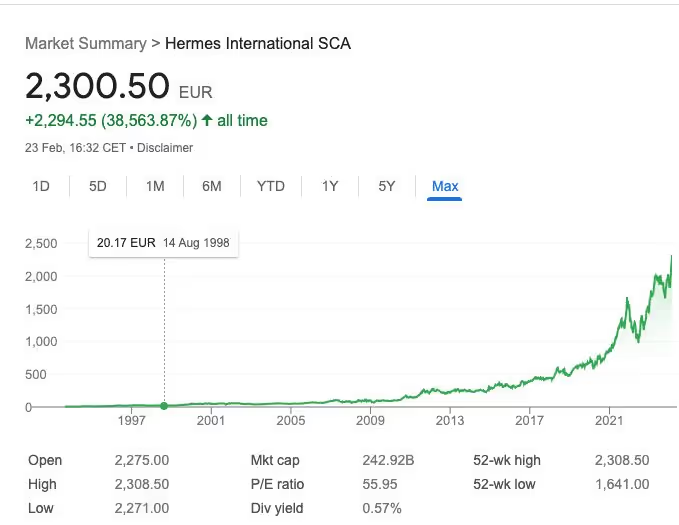The real reason why Hermès bags sell for $300,000
What comes to mind when you hear the phrase “great customer experience”?
I bet it includes a seamless digital interface, exceptional product quality, speed, convenience, responsive and pleasant omnichannel customer service, aftercare included, and the “customer is always right” mentality.
What if I told you that most of the truly successful brands don’t follow this formula? In fact, the very reason they are successful is they have honed in on their own unique formula.
One of the best examples of this is Hermès.
If you're anything like me, you likely never purchased anything from Hermès and probably never given it much thought but this is a company you should definitely study.
Hermes is over 180 years old, but it is still doing very well, with the share price increasing 4x over the last five years at the time I’m writing this and 39x since its listing in the 90s.

And it achieved this long-lasting success in spite of not following the “best practice.”
Their model is extremely hard to pull off, but the payoff for those who do can be incredible.
The power of knowing your best customers
The Hermes approach to customer experience starts with consciously deciding not to please everyone.
Instead, they focus on the best-fit customers, knowing that this requires a steadfast commitment to controlled scarcity.
While most brands strive for ubiquity, Hermès embraces the power of exclusivity.
Their production is deliberately limited to ensure the highest quality standards, creating an aura of desirability that only fuels demand.

Take, for instance, the legendary Hermès Birkin bag, with prices ranging from $9,000 to well over $300,000 for the rarest iterations.
But the price isn’t even what will stop you from owning one.
To get there, you must prove yourself by buying some other item (even better, several) and spending up to several years on a waiting list.
More often than not, you would not even be able to look at the bag in the store.
And, of course, this product is not available in their online store.
It’s hard to say if the exclusivity comes from some of the most intricate craftsmanship, the meticulous attention to detail and heritage dating back to when the company was known for making saddles, or from the price and the limited supply.
Most likely, the two go hand in hand to reinforce the magic.
The point is, where for most brands, selection, convenience, and good value for money are the key components of a strong customer experience, Hermes does the exact opposite, and it works.
As advertising guru Rory Sutherland likes to say, sometimes the opposite of a good idea is another good idea.
In one of our previous issues, we wrote about a very different European company, Ryanair, which similarly knows what it stands for (low prices) and shapes the whole customer experience around it. Hermes does the same with the idea of exclusivity.
This means they do take some of the “best practices” on board and, in fact, dial them up well beyond what most brands would.
Hermes legendary sales associates, trained for years in the art of personal service, engage customers in a dance of discovery, taking the time to understand their preferences and tailor the experience accordingly.
You end up building a relationship with them lasting many years and sometimes generations.
And if you are lucky enough to own one of their pieces, you can expect lifetime service.
In fact, you can bring a bag or a saddle purchased years before you were born and the company will happily attempt to repair it.
In recent years, Hermès began scaling their production way beyond the historic levels.
And yet, even here they did the opposite of most other companies, even those in the luxury industry.
Rather than automating and outsourcing, they figured out a way to train craftspeople on a larger scale.
That allowed them to grow the revenues without compromizing to quality of the product or perceived exclusivity.
What makes our job as the builders of customer experiences so fun is that human beings are fundamentally so diverse and weird that there is no one-size-fits-all approach to making them love your brand.
The three main learnings from Hermes
If there are any learnings from Hermes, I would not overanalyze the specific choices they make in pricing, craftsmanship, or branding. Not unless you also happen to own a piece of heritage in the same league.
Instead, here are my three main learnings:
- Understand what matters to your customers, particularly your best customers. Depending on the business model, your best customers could be a small group or the whole world.
- Play to your strengths. Double down on what matters to this group and keep building the whole customer journey around it. The results will compound over time.
- Once the magic works, scale the experience but carefully monitor it to make sure you have not ruined the magic.
Very few brands ever get all three points right.















